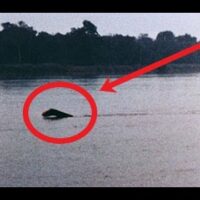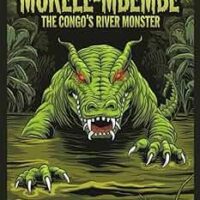Mokele-Mbembe : African Loch Ness Monster
Listen
At a glance
| Description | |
|---|---|
| Origin | Central African Mythology |
| Classification | Hybrids |
| Family Members | N/A |
| Region | Democratic Republic of Congo |
| Associated With | Weather, Swamps |
Mokele-Mbembe
Introduction
Mokele-Mbembe, often described as Africa’s answer to the Loch Ness Monster, occupies a unique space between folklore and cryptozoology. Rooted in the traditions of the Congo River Basin, its name comes from the Lingala phrase meaning “one who stops the flow of rivers,” an image that reflects its size, power, and control over waterways. While popular Western accounts frame it as a living dinosaur, its deeper cultural significance lies in the way it embodies the spiritual bond between people and their environment.
In traditional Bantu belief systems, rivers are more than geographic features—they are living pathways connecting the human world to ancestral realms. Within this worldview, Mokele-Mbembe is not merely a physical animal but a guardian spirit, ensuring that the rivers remain pure and respected. Over time, this indigenous spiritual narrative was reshaped by colonial explorers, missionaries, and cryptozoologists, giving rise to the modern image of a prehistoric survivor lurking in Africa’s swamps.
Physical Traits
Eyewitness descriptions of Mokele-Mbembe are remarkably consistent despite coming from different communities across Central Africa. It is often said to resemble a sauropod dinosaur, with a long, snake-like neck, a thick body, and a muscular tail that can lash through water or vegetation with ease. Its skin is usually described as smooth and grayish-brown, similar to that of an elephant, though some reports suggest a faint pebbled texture.
The head is small in proportion to the body, sometimes depicted with a single horn or crest, and the creature moves on four strong, pillar-like legs that allow it to navigate swampy terrain. Measuring anywhere from the size of a hippopotamus to that of a small elephant, Mokele-Mbembe is thought to be entirely herbivorous, favoring aquatic plants and specific flowering vines that grow near riverbanks. Locals describe it as strong enough to topple trees or capsize canoes, which reinforces its reputation as a powerful presence within its watery territory.
Family
Unlike many mythological beings that belong to elaborate pantheons, Mokele-Mbembe is typically portrayed as a solitary guardian rather than part of a visible family group. In Bakongo cosmology, however, it could be classified within the broader category of nkisi—spiritual forces associated with natural elements. In this sense, it belongs to a spiritual “family” of river guardians and water spirits that can be found in traditions worldwide, such as the naga of South Asia or the bunyip of Australian Aboriginal mythology.
For the Bakongo, such beings are often manifestations of ancestral power. Some elders interpret Mokele-Mbembe as an ancestral envoy, sent to protect sacred lands and waterways from exploitation or harm. In this framework, the creature’s solitary nature reflects the independence and singular authority of spiritual protectors, who answer only to the divine and ancestral forces that gave them life.
Other names
While “Mokele-Mbembe” is the most widely recognized name thanks to Lingala-speaking communities, other variations exist throughout the Congo Basin. Neighboring tribes and explorers have used terms such as n’yamala, badigui, and mbilintu, though these sometimes refer to similar but distinct creatures. In the Aka language, “mokele-mbembe” can even serve as a general term for large, unidentified animals, which has caused occasional confusion when comparing stories.
The Emela-Ntouka, another legendary Congo Basin animal, is often mistaken for Mokele-Mbembe. While they share similarities—large size, smooth hide, and aquatic habits—the Emela-Ntouka is said to possess a more aggressive temperament and a prominent horn, resembling a prehistoric rhinoceros. Such overlaps in description suggest a complex web of regional myths that have blended and evolved through centuries of oral storytelling.
Powers and Abilities
In traditional accounts, Mokele-Mbembe’s power lies as much in its spiritual presence as in its physical strength. It is said to fiercely defend its territory, overturning canoes and frightening away intruders who disturb the river. Some legends attribute the flooding or diversion of waterways to its movements, suggesting it can influence the very flow of water.
Elders in the region sometimes describe it as having the ability to vanish into mist or disappear beneath the water without leaving a trace—an attribute that places it firmly in the realm of the supernatural. Encounters with Mokele-Mbembe are often interpreted as omens, signaling either environmental disruption or a warning from the ancestors. These traits highlight its dual existence: part creature of the natural world, part guardian spirit with authority over the river’s balance.
Modern Day Influence
The modern story of Mokele-Mbembe has been shaped by a century of expeditions, speculation, and media portrayals. From the 20th century onward, cryptozoologists and adventurers have traveled deep into the Congo Basin in search of physical proof. Some explorers returned with eyewitness testimonies and sketches, while others claimed to have seen the creature firsthand—though no definitive evidence has ever been produced.
Scientific opinion remains skeptical. Many biologists believe the accounts may stem from sightings of familiar animals such as manatees, crocodiles, or the now-vanished black rhinoceros. Despite this, Mokele-Mbembe has become an icon in both cryptozoology and popular culture, appearing in films, documentaries, novels, and even video games. Its image as a “living dinosaur” has been reinforced by Western fascination with prehistoric life, particularly following the success of adventure literature like Arthur Conan Doyle’s The Lost World.
In some circles, the creature has been used as a cultural symbol. Conservationists invoke Mokele-Mbembe to draw attention to the biodiversity of the Congo Basin, while local communities see the legend as a reminder of the sacredness of their natural heritage. The story has also been adopted by certain religious groups—particularly young Earth creationists—who argue that its existence would challenge the scientific timeline of evolution.
Today, Mokele-Mbembe stands at the crossroads of myth, science, and cultural identity. For the people of the Congo Basin, it remains a deeply rooted spiritual entity tied to the health of the rivers. For the outside world, it is a tantalizing mystery—an emblem of the unknown that continues to inspire expeditions, documentaries, and endless debate. Whether viewed as a relic from the age of dinosaurs or as an enduring river spirit, the legend of Mokele-Mbembe endures, carried forward by both ancient belief and modern curiosity.
Related Images
Source
Agnagna, M. (1983). Recherche de la Mokele-Mbembe.
Dunning, B. (2009). Skeptoid: Critical Analysis of Pop Phenomena.
Doyle, A. C. (1912). The Lost World. Hodder & Stoughton.
Gibbons, W. J. (2002). The Institute for Creation Research.
Ley, W. (1941). The Lungfish and the Unicorn. Viking Press.
Mackal, R. P. (1987). A Living Dinosaur? In Search of Mokele-Mbembe. E.J. Brill.
Nugent, R. (1993). Drums Along The Congo: On The Trail Of Mokele-Mbembe, the Last Living Dinosaur. Houghton Mifflin.
Prothero, D. R. (2013). Abominable Science!: Origins of the Yeti, Nessie, and Other Famous Cryptids. Columbia University Press.
Black, R. (2011, October 28). Living Sauropods? No Way. Smithsonian Magazine. https://www.smithsonianmag.com/science-nature/living-sauropods-no-way-120910306/
Biller, R. (2025, February 4). What’s behind the strange rash of ‘dinosaur’ sightings in the Congo? National Geographic. https://www.nationalgeographic.com/environment/article/congo-basin-mokele-mbembe-deforestation
Bowie, D. (n.d.). Mokele-Mbembe: The Truth Behind Africa’s Mythical River Monster. HowStuffWorks. https://science.howstuffworks.com/science-vs-myth/strange-creatures/mokele-mbembe.htm
Wikipedia contributors. (2023, August 10). Mokele-mbembe. Wikipedia. https://en.wikipedia.org/wiki/Mokele-mbembe
The Daily Journalist. (n.d.). History of Mokele Mbembe And Expeditions To Africa. Think Research Expose. https://thedailyjournalist.com/the-historian/history-of-mokele-mbembe-and-expeditions-to-africa/
Frequently Asked Questions
What is lorem Ipsum?
I am text block. Click edit button to change this text. Lorem ipsum dolor sit amet, consectetur adipiscing elit. Ut elit tellus, luctus nec ullamcorper mattis, pulvinar dapibus leo.
What is lorem Ipsum?
I am text block. Click edit button to change this text. Lorem ipsum dolor sit amet, consectetur adipiscing elit. Ut elit tellus, luctus nec ullamcorper mattis, pulvinar dapibus leo.
What is lorem Ipsum?
I am text block. Click edit button to change this text. Lorem ipsum dolor sit amet, consectetur adipiscing elit. Ut elit tellus, luctus nec ullamcorper mattis, pulvinar dapibus leo.
What is lorem Ipsum?
I am text block. Click edit button to change this text. Lorem ipsum dolor sit amet, consectetur adipiscing elit. Ut elit tellus, luctus nec ullamcorper mattis, pulvinar dapibus leo.
What is lorem Ipsum?
I am text block. Click edit button to change this text. Lorem ipsum dolor sit amet, consectetur adipiscing elit. Ut elit tellus, luctus nec ullamcorper mattis, pulvinar dapibus leo.









